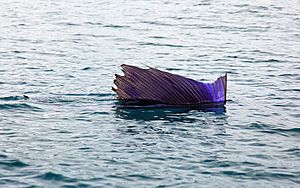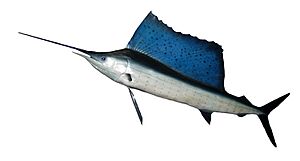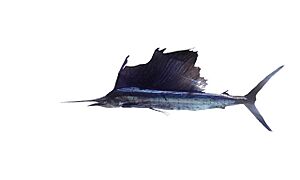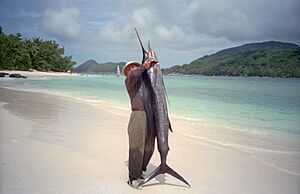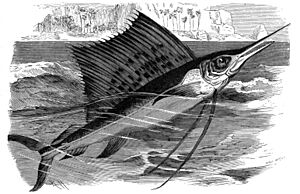Indo-Pacific sailfish facts for kids
Quick facts for kids Indo-Pacific sailfish |
|
|---|---|
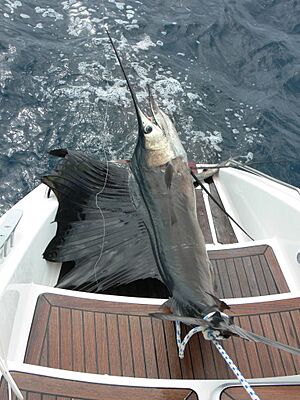 |
|
| Conservation status | |
| Scientific classification | |
| Synonyms | |
|
The Indo-Pacific sailfish (Istiophorus platypterus) is a fascinating and incredibly fast fish. It is famous for its large, sail-like dorsal fin and its long, pointed bill. This amazing creature lives in the warm waters of the Indian Ocean and Pacific Ocean, and has also made its way into the Atlantic Ocean and Mediterranean Sea.
Contents
What Does a Sailfish Look Like?
The Indo-Pacific sailfish has a striking appearance.
It's a deep, dark blue on its back, which helps it camouflage from predators looking down from above, blending with the dark ocean floor or deep water.
Laterally, meaning along its sides, it transitions to a beautiful brown-blue hue. This gradient helps it disappear into the varying light conditions of the water column.
Its underside is a silvery white. This bright color helps it hide from prey or predators looking up from below, as it reflects the bright sunlight filtering through the water, making it hard to distinguish from the surface glare.
One of the most recognizable features of the sailfish is its upper jaw. It's not just a regular mouth; it's elongated and shaped like a spear or a bill. This isn't just for show; it's a crucial tool for hunting.
Its first dorsal fin is very large and shaped like a sail. This fin has many black spots and is tallest in the middle.
Beyond the spectacular sail, other fins and body features contribute to the sailfish's streamlined and powerful form:
- Pelvic Fins: These fins are very narrow and surprisingly long, reaching almost all the way back to the anus of the fish. Their exact role in swimming or stability is still studied, but they are clearly adapted for high-speed movement.
- Body Covering: The sailfish's body is covered with embedded scales. Unlike some fish with large, obvious scales, these are blunt at the end and are tucked into the skin, contributing to its smooth, hydrodynamic shape, which is essential for speed.
- Lateral Line: The lateral line is a sensory organ found in fish that helps them detect vibrations and pressure changes in the water. In the sailfish, this line curves gracefully above its pectoral fin (the fin behind its gills) and then runs straight back to the base of its tail. This sophisticated sensory system is vital for navigating and hunting in the vast ocean.
In summary, the Indo-Pacific sailfish is a creature of incredible design, from its camouflage colors to its spear-like jaw and its iconic sail, every part of it is built for life in the fast lane of the ocean.
Where Do Sailfish Live?
The Indo-Pacific sailfish is truly a global traveler, making its home across vast stretches of the world's oceans.
They are common and widespread in the tropical and sub-tropical regions of both the Atlantic and Indo-Pacific oceans.
While they prefer warmer waters, sailfish are also known to range into temperate waters. Temperate zones are cooler regions located between the tropics and the polar circles. A significant expansion of their range occurred when they entered the Mediterranean Sea via the Suez Canal. This makes the Mediterranean Sea another part of their habitat.
How Do Sailfish Hunt?
Sailfish are expert hunters. They use their large, sharp bill to catch their prey. They feed on fast fish like tuna and mackerel, which are some of the quickest swimmers in the ocean. Sailfish are known for their incredible speed, making them one of the fastest fish in the world.
The Mystery of the Sail
Scientists are still learning about the sailfish's unique dorsal fin. Marine biologists believe the 'sail' might help the fish control its body temperature. The theory suggests that by raising its sail to the surface, the sailfish can expose this large, blood-rich fin to the surrounding water or even the air. If the fish has just engaged in a high-speed chase, its muscles would have generated a lot of heat. Raising the sail could allow the blood flowing through those vessels to cool down quickly by releasing heat into the cooler surface water or air.
Conversely, if the fish needs to warm up, perhaps after diving into colder depths, exposing the sail to warmer surface waters or sunlight could help absorb heat.
This incredible adaptation would allow the sailfish to maintain an optimal body temperature, which is crucial for its high-performance lifestyle. Being able to regulate its temperature efficiently means it can recover faster after intense activity and be ready for its next hunt or escape. It's a testament to how specialized and complex marine life can be!
Sailfish and People
Even though some people fish for sailfish on purpose, they are often caught by accident. This happens when boats are fishing for tuna using longlines. Sailfish are not usually kept because other fish, like marlin, are more valuable. Many are released back into the ocean. People who fish for fun enjoy catching sailfish because they put up a strong fight!
Sailfish are incredibly popular among recreational anglers, who are people who fish for sport or leisure rather than for commercial purposes. They are considered a "hard-fighting game fish."
How Many Sailfish Species Are There?
Even with all our scientific knowledge, sometimes experts don't always agree on everything, and that's perfectly normal in the world of science! The number of recognized sailfish species is one such area of discussion among marine biologists.
Many scientific authorities, including a large number of marine biologists, recognize only a single species of sailfish worldwide. They believe that all sailfish, whether found in the Atlantic, Indian, or Pacific Oceans, belong to the same species: Istiophorus platypterus. This view suggests that the differences observed between sailfish in different regions are variations within the same species, perhaps due to local environmental factors or genetic drift, rather than being distinct species.
FishBase is a comprehensive online database of fish species. Interestingly, FishBase recognizes two distinct species of sailfish. This difference in opinion highlights the ongoing nature of scientific research and classification. Scientists continually gather new data, conduct genetic analyses, and observe behavior to refine our understanding of biodiversity. For now, the single-species view is more widely accepted, but research continues!



